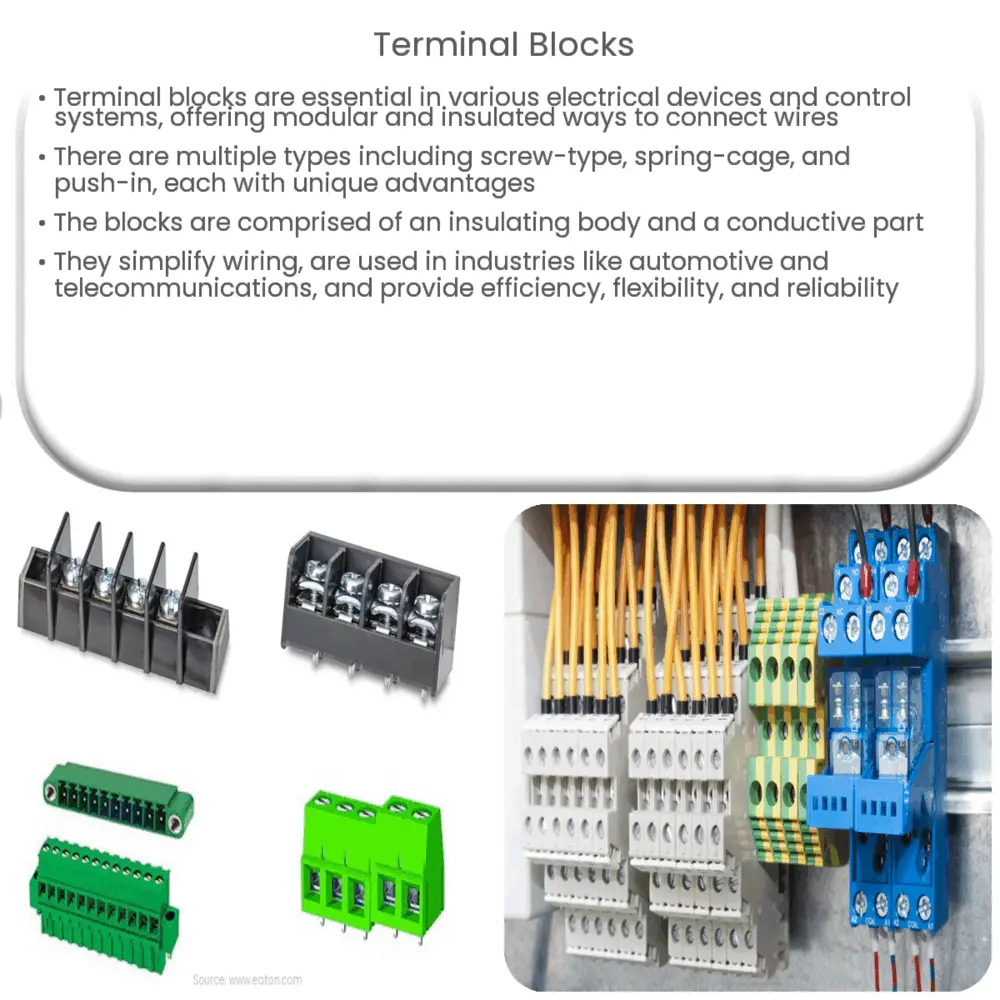Explore the vital role of terminal blocks in various industries. Learn about their types, components, applications, and benefits in this comprehensive guide.

Introduction to Terminal Blocks
A terminal block is an essential component in many electrical devices and control systems. These are modular, insulated devices that secure two or more wires together. Terminal blocks come in a variety of shapes and sizes, each designed to meet specific requirements. The versatility and convenience offered by these devices make them a staple in various industries, including automotive, telecommunications, and industrial controls.
Types of Terminal Blocks
There are numerous types of terminal blocks, each with its unique features, advantages, and applications. Let’s take a look at some of the most common ones:
- Screw-type Terminal Blocks: These are the most common types. In these, the wires are connected by screwing them into place. They provide a sturdy and reliable connection, though the process can be time-consuming.
- Spring-cage Terminal Blocks: Offering a quicker alternative to screw-types, spring-cage terminal blocks use a spring mechanism to secure wires. They’re known for maintaining a stable connection, even under conditions with heavy vibration.
- Push-in Terminal Blocks: Also known as IDC (Insulation-Displacement Contact) terminal blocks, these are designed for speed and ease of use. The wires are pushed into the terminal block, where they make contact with a metal fork that slices through the insulation and creates a connection.
Components and Working of Terminal Blocks
Despite the variation in types, the basic components of terminal blocks remain the same:
- Insulating Body: This is the main body of the block, usually made from a hard plastic or ceramic material. It provides mechanical support for the terminal and insulates it from the surrounding environment.
- Conductive Part: This is the part that connects the wires together. It is typically made from a conductive metal like copper or brass and is designed to maintain a secure and efficient electrical connection.
The working of a terminal block is relatively straightforward. The stripped ends of the wires are inserted into the terminal block, and then secured in place using the block’s specific mechanism, such as a screw, spring, or push-in system. The conductive part of the block allows for the transfer of electrical signals or power between the connected wires.
Applications of Terminal Blocks
Terminal blocks are indispensable in a variety of applications, owing to their ability to simplify complex wiring systems. Here are a few key areas where they’re commonly used:
- Industrial Control Systems: Terminal blocks are frequently used in control systems to connect sensors, actuators, power supplies, and other devices. They enable easy modifications and troubleshooting in these systems.
- Telecommunication: These blocks play a significant role in connecting and managing the many wires required in telecommunication systems, thus ensuring efficient and reliable connections.
- Automotive: In the automotive industry, terminal blocks are used in fuse boxes and control systems, helping to manage the numerous electrical connections within vehicles.
Benefits of Using Terminal Blocks
The advantages of using terminal blocks are numerous, some of which are:
- Efficiency: Terminal blocks streamline the wiring process, making it more efficient and easier to manage.
- Flexibility: These blocks can be easily rearranged or replaced, providing flexibility in system design and modifications.
- Reliability: Terminal blocks offer secure and reliable connections, reducing the risk of connection failures and related issues.
Conclusion
In conclusion, terminal blocks are an integral component of many electrical and electronic systems. Their versatility, efficiency, and reliability make them indispensable in a variety of industries and applications. From basic screw-type blocks to advanced push-in models, these devices have evolved over the years to meet the growing demands of modern electrical systems. Despite their humble appearance, the role they play in facilitating secure and efficient connections is truly substantial. Whether it’s in an industrial control panel or a car’s fuse box, terminal blocks prove that great things often come in small packages.

